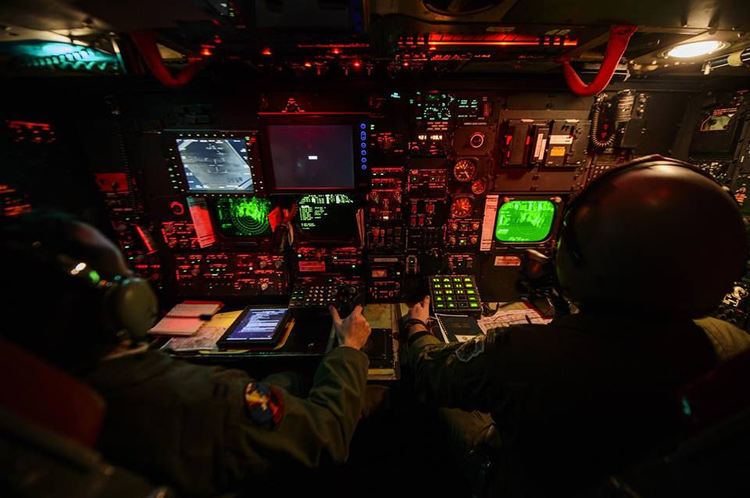Active 1917–present Garrison/HQ Minot Air Force Base | Country United States | |
 | ||
Branch United States Air Force Role Strategic bombing
Air interdiction Part of 5th Bomb Wing
Eighth Air Force
Air Force Global Strike Command | ||
The 23d Bomb Squadron (23 BS) is a United States Air Force unit, assigned to the 5th Bomb Wing. It is stationed at Minot AFB, North Dakota. The mission of the 23BS is to fly the Boeing B-52H Stratofortress long-range bomber. The squadron stands ready to deploy and fly its B-52Hs to enforce national security policy by being ready to deliver overwhelming nuclear or conventional firepower to destroy targets, worldwide, at any time.
Contents
The squadron is one of the oldest in the United States Air Force, its origins dating to 16 June 1917, being organized at Kelly Field, Texas. It deployed to England as part of the American Expeditionary Forces, being engaged as an aircraft repair squadron during World War I. The squadron saw combat during World War II, and became part of the Strategic Air Command (SAC) during the Cold War.
Unit patch
The insignia is a blue disk with a black volcano with red lava flowing from the crater, extending upward as red and yellow rays intermingling with clouds. On the front are five black bombs signifying the 23 BS with three on the dexter (right) side, and two on the sinister (left) side. The patch was approved on 30 September 1931.
On 27 December 1935 fate stepped in, and the unit was actually tasked to drop twenty 600-pound bombs in the path of the flow of lava from Mauna Loa volcano, thus saving the city of Hilo, Hawaii, from destruction. It is worn proudly by all members and is a constant reminder of their heritage.
World War I
Originally organized on 16 June 1917 as the 18th Aero Squadron but redesignated 23d six days later, the 23d supported World War I air combat operations serving as an aircraft and engine repair depot organization. Demobilized shortly after the Armistice with Germany (Compiègne).
Inter-war years
The 23d was reborn in 1921 and spent the decades of the 1920s and 1930s stationed in Hawaii. There, the squadron flew a number of bomber types, most notably the Keystone bomber series and later the Douglas B-18 Bolo. It was during the squadron’s stay in Hawaii that the event signified by the squadron patch took place. On 27 December 1935, the Mauna Loa volcano on the island of Hawaii erupted, threatening the city of Hilo. Six Keystones of the 23d used precision bombing tactics to drop twenty 600-pound bombs in the path of the volcano’s lava flow, thus saving the city of Hilo by diverting the lava away from the city.
World War II
Part of the 5th Bombardment Group, the 23d fought its way across the Southwest Pacific during World War II. The 23d initially flew Boeing B-17E Flying Fortresses into combat, replacing those with Consolidated B-24 Liberators by early 1943. Long-range over-water missions were the squadron’s forte, and in April 1944 the squadron won its first of two Distinguished Unit Citations for flying the longest over-water bombing mission ever flown to date, some 1,300 miles each way, to bomb the Japanese base at Woleai Island. After winning a second DUC for another long range strike against oil refineries on Borneo on 30 September 1944, the 23d found itself in the Philippines at the close of the war.
Cold War
After a brief period in the Far East after the war, the 23d Strategic Reconnaissance Squadron relocated to Travis AFB, Calif., in 1949. There, the squadron flew global strategic reconnaissance missions with Boeing RB-29 Superfortresses from 1949–51, Convair RB-36F Peacemakers from 1951–53, and RB-36Hs from 1953-55. On 1 October 1955, the squadron was again redesignated 23d Bombardment Squadron and reverted to training for long range nuclear strike missions with the same RB-36Hs. On 13 February 1959, the 23d entered the jet age when it received its first Boeing B-52G Stratofortress and also entered the missile age, as the B-52Gs were equipped with the then-new Stand-off AGM-28 Hound Dog and ADM-20 Quail decoy missiles. The squadron flew the B-52G from Travis until July 1968.
On 25 July 1968, the 23d moved, without personnel or equipment, to Minot AFB, where it absorbed the personnel, equipment, and B-52H bombers of the inactivating 720th Bombardment Squadron. The 23d has been combat ready in B-52Hs since that time, continuously adding improvements in avionics, weapons, and tactics to its arsenal. In 1973, the squadron was the first unit to receive the AGM-69 SRAM (Short Range Attack Missile). In 1980, the 23d gained the Offensive Avionics System, and led Strategic Air Command’s venture into modern conventional war fighting as the lead unit for the Strategic Projection Force, in support of the U.S. Rapid Deployment Force. During the 1980s, the squadron pioneered night vision goggle tactics. The 23d added the AGM-86B ALCM (Air Launched Cruise Missile) in 1989 and the AGM-129 Advanced Cruise Missile (ACM) in 1994.
Lineage
* Another 18th Aero Squadron was activated at Rockwell Field, California on 20 August 1917. It was later re-designated as the 18th Observation Squadron on 25 January 1923. It was last inactivated as the 408th Bombardment Squadron on 1 January 1962.
